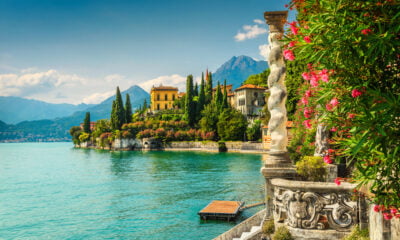

Sustainability
Sustainable Ways to Enjoy Israeli Historical Landmarks
Sustainability is one of the most critical aspects of all business sectors nowadays. Most industries across the world have understood the importance of supporting green practices. Travelling is one of the industry niches usually discussed when discussing sustainability. One survey last year found that 72% of people want to travel more sustainably.
Eco-friendly practices in this sector aim to find responsible and environmentally conscious solutions, including ensuring the natural landscape isn’t damaged and that local communities are respected. For example, depending on the terrain, you might have to walk at a different pace to not damage the soil, respecting the rules and requirements of the region you visit and being mindful of cultural differences.
Among the many locations you can visit, Israel is one of the most special. It is home to an ancient culture and a holy place for three major religions, making visiting a genuine spiritual experience.
We mentioned some great eco-friendly ways to enjoy nightlife in Tel Aviv. However, there are other ways to enjoy traveling sustainably in Israel.
Israel is also the seat of some of the most incredible historical landmarks in the world. Here are just a few you must make sure you don’t miss the next time you visit the country.
Avdat
Situated in the Negev desert, in the south of Israel, the once prosperous city was inhabited by several civilizations, including the Nabataeans, Romans, and Byzantines. The city was once the most important city on the ancient Incense Trade Route, spanning between the Mediterranean, the Levant, Northeastern Africa, India, and even beyond. Incense wasn’t the only product sold via this route, as other luxury goods, such as pearls, gemstones, myrrh, feathers, animal skins, wood and fine textiles, were also popular.
Nowadays, Avdat is officially a UNESCO-designated World Heritage Site, and tourists from all over the world visit it every year. When you come to this magnificent site, you won’t only see fortifications or military architecture but also relics of the past alluding to the daily life of the people living in the city, like a bathhouse and caravanserai, a type of inn in which travelers could stop and rest for a while.
And while many ruins are of Roman origin, the original Nabataean influence is still easily observable, particularly in the remains of the temples.
Church of the Holy Sepulchre
Located in the Christian Quarter in the Old City of Jerusalem, the Church of the Holy Sepulchre is a must-visit for anyone on a green Christian pilgrimage to the Holy Land. The church is the holiest place in all of Christianity because it is the location of two sites that are incredibly important for the religion, namely Golgotha, the location of the crucifixion of Jesus, and Jesus’ empty tomb. The last four stations of the Cross are also located within the church, representing the final part of the Passions of Christ.
Several Christian denominations share control of the church, including the Catholic, Greek, Ethiopian, Coptic and Syriac Orthodox churches. There are several artifacts of historical and religious importance to visit within the Church of the Holy Sepulchre, such as the Stone of the Anointing, standing for the place where Jesus was prepared for burial. Nearby are several Crusader graves dating back to the 11th and 12th centuries, which were unfortunately desecrated during the early 1800s.
The Syriac Chapel with the Tomb of Joseph of Arimathea, the seven Arches of the Virgin at north of the Catholicon and the Prison of Christ are other landmarks within the church complex that you must visit during your pilgrimage.
Haluza
Another wonder in the desert, Haluza, was also once part of the Incense Route. Located between Petra and Gaza, it was one of the most important centers for trade during its heyday. The excavations uncovered in the area have revealed many inscriptions and artifacts. Work in the region is unfortunately hampered by the shifting sands. Yet, several Nabataean streets, a theater, churches, and even wine presses have been discovered. This is noteworthy considering that vineyards have surrounded the area since the 5th century, establishing the region as an important center for winemaking.
Masada
The Masada, a Hebrew word meaning “fortress”, is an ancient fortified construction located atop an isolated rock plateau. It overlooks the Dead Sea and the Judaean Desert on the eastern side. According to accounts by a Roman historian, a siege carried out by Roman troops at the end of the First Jewish-Roman War ended in mass suicide for the rebels located inside the fortress.
The Masada is one of the most popular destinations for tourists coming to Israel, with nearly one million visitors yearly. The remains of the fortification are incredibly well-preserved, as are those of the Roman military camps located nearby. If you want to hike to the top, the best time to start is around an hour before sunrise to avoid the heat, which can exceed 43 °C during the summer months. You can choose from two hiking paths, the Snake and the Roman trails, both of which are quite steep, so you should be sure-footed to make the climb.
You can also take a cable car to the top. Nearby, there’s also a museum and a center for visitors if you want to learn any additional information. To understand the cultural implications of the place better, you can try learning some basic Hebrew to help you during your trip. My Israel books offer language and Jewish studies textbooks for beginners and more advanced learners, so you can brush up on your knowledge before going on the trip.
Golan Heights
Situated between the Jordan River and the Sea of Galilee, the Golan Heights is one of the country’s most incredible regions to explore. It is home to several archaeological sites, including the Banias, continuously inhabited for 2,000 years until 1967; Deir Qeruh, A Byzantine-era village with a monastery dating back to the 6th century; and the Nimrod Fortress built by the Ayyubids and Mamluks as a defense against the Crusaders.
Hippos, a city dating back to the Greco-Roman period, features a city forum, temple compounds and classic Roman city gates, while at Tell Hadar, historians discovered several buildings and ancient storage facilities. All the cultural landmarks in the Golan Heights offer a good indication of the eclectic and diverse mix of cultures in the region throughout the centuries, each bringing in its own customs and knowledge.
When you want to visit Israel, you should be prepared for a life-changing trip that’ll provide you with a culturally enriching experience.


 Environment10 months ago
Environment10 months agoAre Polymer Banknotes: an Eco-Friendly Trend or a Groundswell?

 Environment12 months ago
Environment12 months agoEco-Friendly Home Improvements: Top 7 Upgrades for 2025

 Features9 months ago
Features9 months agoEco-Friendly Cryptocurrencies: Sustainable Investment Choices

 Features10 months ago
Features10 months agoEco-Friendly Crypto Traders Must Find the Right Exchange




























